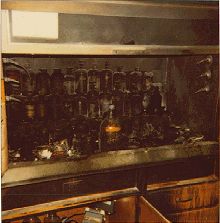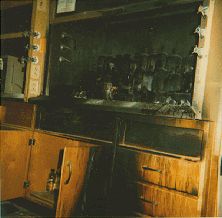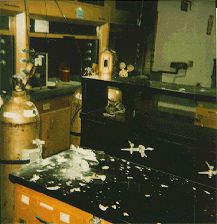| Page 3 |

|
|
1 - Chemical Safety
2 - Page 2 3 - Page 3 4 - Page 4 5 - Page 5 6 - Page 6 |

 HOME
HOMEIn the spring 1997 at the University of Kentucky, incompatible wastes were accidentally mixed resulting in a fire and explosion. It is believed that nitric acid and halogenated organic solvents were involved, but the exact cause may never be known.
It is miraculous that there were no serious injuries from this explosion and fire. The student who last used the waste bottle reported that he saw some brown fumes coming from the waste bottle when he added his methylene chloride. He capped the bottle and walked away. A minute or two later it exploded.
The explosion blew glass shrapnel across the laboratory. Students on the other side of the laboratory were hit with glass fragments, including at least one who reported that the glass bounced off his safety goggles. Thankfully, this student was following the rule you must wear your safety glasses at all times in the laboratory even if you aren't "doing anything."
A fire immediately followed. The hood was completely engulfed in flames and the laboratory (approximately 2000 square feet) quickly filled with smoke so black, thick and acrid that one could not see across the lab. Fortunately, everyone was evacuated and there were no injuries. The fire was contained by faculty members who took a serious (and some would say extremely foolish) risk in battling this large and dangerous fire themselves.
Serious injuries were avoided only because the student who normally works opposite that hood was not present at the moment of the explosion. Explosions of this nature can have an induction period ranging from one second to one hour or more. The last student to use this waste bottle was incredibly lucky.
Pictures from the accident scene:
 | Figure 1. View of the fume hood where the accident occurred. Notice the large number of chemicals involved in the conflagration and the broken/melted chemical containers. Notice the large number which did not shatter or break, but could have detonated while the fire was being extinguished. |
 | Figure 2. A second view of the fume hood involved in the fire. Notice the severe charring of the cabinetry. |
 | Figure 3. Shrapnel damage. The hood involved in the fire is in the rear of the photo (notice the soot/char above the hood). The white material on this benchtop (3 hoods away) is the remains of the overhead fluorescent lights which were shattered by flying debris. Other glass fragments from the explosion traveled up to 10 meters from the hood; some were found imbedded up to 20 mm deep in the fume hood ductwork insulation. |
Preventing Mistakes of This Nature
There are several ways that incidents of this nature can be avoided or the damage minimized.
Pay Attention to what you are doing! Lab accidents happen most often when you are cleaning up or doing something you think isn't dangerous. If you notice an unusual fog etc. coming from a waste bottle do not cap it. Close the hood sash and notify your supervisor immediately.Always double check the label before pouring anything (waste or otherwise). In the case above, someone in the lab did not read the tag on the waste bottle. Never assume that a bottle is reagent or waste just by its color or size! Again, pay attention to what you are doing!
Properly label your reactions and containers. A label is not just crossing out "Hydrochloric acid" and writing "waste", "waste acid" etc. in magic marker. There are specific rules and procedures to follow!
Hoods are not meant for chemical storage. In the case above, the hood was being used for the storage of well over 30 different chemicals as well as waste materials. If you're not using certain chemicals, put them away. If the hood has to be used for storage of nasty chemicals, find a different hood to run your reaction.
Never run experiments in hoods where waste is stored. Do not use or store incompatible materials in the same fume hood. In the case above, the combination of organics, acids and bases contributed to the resulting fire, forced the closure of the building for several hours and costing a lot of time and money for cleanup.
Minimize potential injury. When possible, avoid performing benchtop work immediately across from a fume hood that is being used for waste collection or an experiment.
Use the fume hood correctly. Keep the fume hood sash closed except when necessary to contain accidental fires, ejecta and shrapnel (as well as fumes).
Do not perform unauthorized experiments. Not only is this generally forbidden, but it increases the chance of an accidental mixing of incompatible chemicals. A student doing this in a lab course may be expelled from the laboratory, charged with a crime, and/or receive a failing grade in the course. Don't risk injury to yourself and others, your GPA, those dreams of med school, or whatever by pulling a stupid lab stunt.
If you see any potentially dangerous situations in your laboratory, notify your supervisor immediately. Make sure that the situation is rectified -- supervisors can get very busy; if necessary, go to your supervisor's supervisor. If necessary, create a paper trail to pressure them into action. Don't assume that all is well just because you've reported the problem!
| << Previous 1 2 [3] 4 5 6 Next >> |
